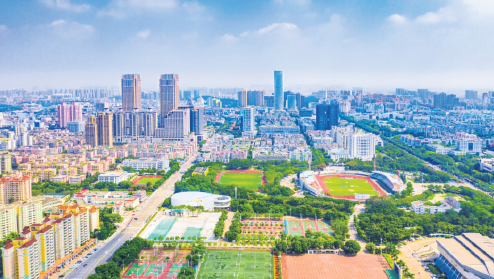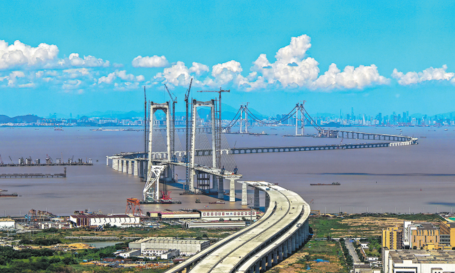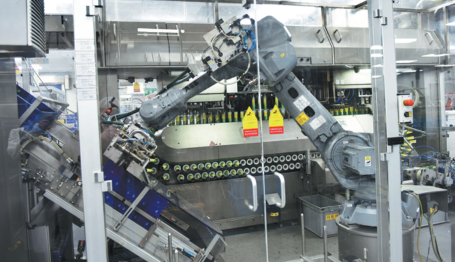Zhongshan eyes collaboration for both sides of Pearl River
Manufacturing integration most important aspect of cooperation with Shenzhen
Zhongshan is embracing a new opportunity arising from efforts to collaboratively develop the cities on the east and west banks of the Pearl River in South China's Guangdong province.
The city government took the opportunity in a new arrangement of Guangdong to be a province-level reform and innovation pilot zone in June. The move has been widely seen as an essential step to improve the overall strength of the Guangdong-Hong Kong-Macao Greater Bay Area.
Currently, the cities on the western side of the Pearl River, including Zhongshan, are lagging behind those on the eastern side, such as Shenzhen and Dongguan.
Zhongshan will take Shenzhen as a benchmark to improve its business environment, industrial performance, transportation infrastructure, technological innovation, social management and urban planning, so that the east and west bank cities can better integrate in the future, said Guo Wenhai, Party secretary of Zhongshan.
A 24-kilometer bridge is under construction to connect Shenzhen and Zhongshan, which is expected to open in 2024. It will reduce the travel time between the eastern and western sides of the Pearl River from two hours to 30 minutes.
"By building the pilot zone, Zhongshan will try to find a solution for the integrated development of the Bay Area," Guo said.
Creating an excellent business environment is what the city government has long been engaged in, and has been put at the top of its agenda. But Guo said there is room to improve.
These include "shortening the administrative approval process, enhancing the information exchanges and connections among different government departments and better serving the companies," Guo said, adding the city aims to be one of the best in the Bay Area in government approval system for companies.
The most important aspect of Zhongshan's integration with Shenzhen lies in industrial integration, he said.
Shenzhen, which ranks third by GDP among Chinese mainland cities, has mapped out 20 major industries and eight future industries, including synthetic biology, blockchain, cell and gene, and aerospace technology.
Due to a land shortage in Shenzhen, Zhongshan is preparing spacious industrial parks to meet the manufacturing needs of the companies from the other side of the river.
The government of Zhongshan has invested 5 billion yuan ($697 million) to help traditional manufacturing companies upgrade their facilities in a digitalized, intelligent way.
"Shenzhen and Zhongshan are complementary. We can make sure the safety and stability of the industrial chain and supply chain for Shenzhen," said Guo.
The two cities are complementary in fields of innovation — Shenzhen can make full use of Zhongshan's strong manufacturing capability to turn the technological achievements into mass production while Zhongshan could take advantages of Shenzhen's innovation and talent resources to upgrade its traditional manufacturing, he noted.
To better propose the innovation collaboration between the east and west bank cities, Zhongshan will actively participate in construction of the high-tech hubs in the Bay Area. Meanwhile, it spares no effort to foster some strategic emerging industries locally, aiming to be an innovation center among the west bank cities. The industries include new generation information and technology, high-end equipment production and biomedicine.
The city is also increasing investment in transportation infrastructure to connect better with the rest of the Bay Area. It plans to invest 230 billion yuan in the next five years to build rail links and highways, for example, such as a high-speed rail linking Zhongshan with Guangzhou, Zhuhai and Macao. It will greatly cut the travel time to other Bay Area cities when these facilities are ready, the city government said.
Foreseeing a more frequent people flow between Shenzhen and Zhongshan after the operation of Shenzhen-Zhongshan Bridge in 2024, Zhongshan is thinking of a way to coordinate social management with its eastern counterpart.
It attaches emphasis on smart city construction, law reforms, sharing public services, handling the administrative matters of the two cities and public health collaboration, Guo said.
The city will work with Shenzhen to contribute experimental measures in social management for the integration of the Bay Area, he added. The two cities could also jointly develop the urban resources in culture, tourism and historic relics.
Zhongshan is working on raising its level to meet that of Shenzhen in terms of urban development, infrastructure and layout of public facilities, the Party secretary said.
chenhong@chinadaily.com.cn

A bird's-eye view of Zhongshan in South China's Guangdong province. HE FEIKUN/FOR CHINA DAILY

The Shenzhen-Zhongshan Bridge is another mega-transportation infrastructure project in the Pearl River Delta. CHINA DAILY

A smart production system of Hawley & Hazel in Zhongshan. WEN BO/FOR CHINA DAILY








